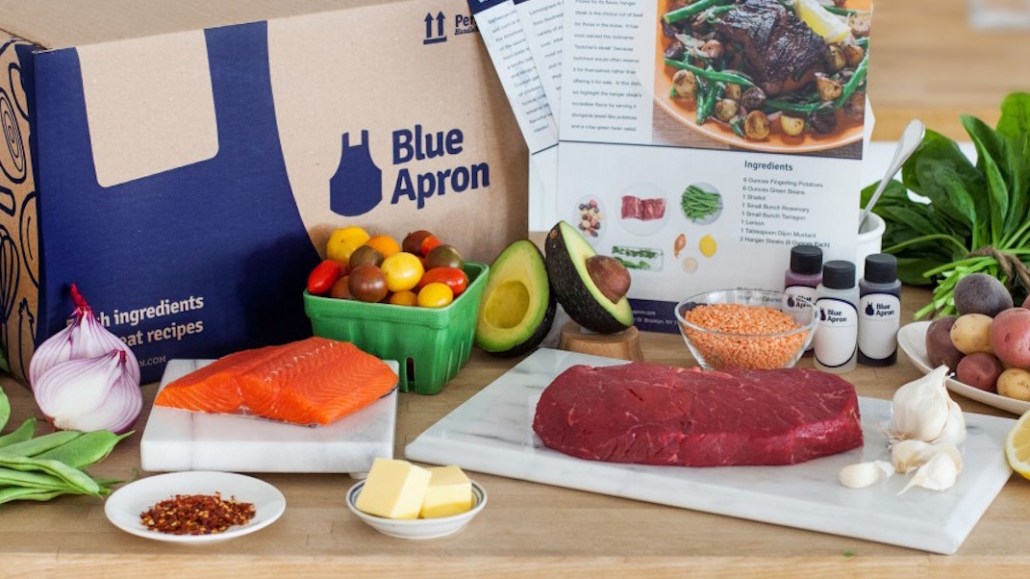Save 50% on a 3-month Digiday+ membership. Ends Dec 12.
How HelloFresh, Blue Apron and Martha & Marley Spoon try to stand out in a crowded meal-kit market

Today it may not be a surprise to see your inbox, Google search and Facebook News Feed filled with ads from meal-kit services with messages like, “Don’t miss out on next week’s recipes” or “Get up to 50 percent off of your first box.”
The concept of offering customers a box of fresh ingredients and easy-to-follow recipes has been a hit. Research firm Packaged Fact said there are more than 150 meal-box brands in the U.S. and predicts U.S. meal-kit delivery services will grow from an estimated $1.5 billion in sales in 2016 to a multibillion-dollar market over the next four years.
There are three market leaders, according to Packaged Facts — Blue Apron, HelloFresh and Plated — and new members like Martha & Marley Spoon have a hard time differentiating themselves in this sector. They are all ultimately offering food in a box.
“Previously, those companies spent lots of marketing dollars educating people on what the category is, and now, they are spending money on differentiation,” said Jamie Gutfreund, global CMO for agency Wunderman.
Blue Apron concentrates on food sustainability, and HelloFresh focuses on the fun and great taste of home cooking, for instance. Martha & Marley Spoon, on the other hand, touts its association with Martha Stewart. Here’s a breakdown.
HelloFresh: making cooking fun
It is the norm for meal-box brands to post appealing images of completed dishes on the likes of Instagram and Pinterest to convince consumers that they can make chef-level meals at home as well. HelloFresh aces this with an in-house content team of photographers and marketers who produce “hundreds of pieces of content per week,” including a monthly magazine, company blog, recipe cards and social posts. HelloFresh is adding a studio so the brand can keep up with the content velocity, said Matthew Fitzgerald, vp of marketing for HelloFresh.
When Sasha Gitin, a New York-based food photographer, scrolled through six major meal-kit services’ Instagram accounts, he immediately noticed the difference.
“HelloFresh comes out as a clear favorite: Flawless composition, good lighting, excellent choice of props, surfaces and backgrounds and very good detail-oriented food styling,” said Gitin. “The images are engaging and appetizing. And the feed is very consistent.”
Gutfreund said HelloFresh also simplifies the cooking experience, creating “chilled boxes” to keep ingredients fresh so the kits can be shipped to offices and then brought home, which makes things easier for working professionals.
Blue Apron: sustainability, community
Blue Apron targets the home cook, with tips from other home chefs so customers can connect with other home cooks. Blue Apron uses podcast advertising to promote how the company is working to change the way food is grown and processed and the meals’ taste, said Greg Fitzgerald, director of customer acquisition for Blue Apron.
While Charlie Hopper, principal and writer for agency Young & Laramore, thinks Blue Apron has humanized the brand well, its challenge is to build an authentic personality in the long run.
“It remains to be seen if Blue Apron can use its lead to differentiate its brand tonality, or if the whole category will lapse into parity products that one chooses for expediency rather than true, emotional brand affinity,” said Hopper.
Martha & Marley Spoon: celebrity connection
As a young company, Martha & Marley Spoon plugs its thousands of recipes from celebrity homemaker Martha Stewart to stand out.
Martha & Marley Spoon has a subscription service, but people can buy individual meals on Amazon, a platform that most meal-kit brands avoid rather than give up their subscription and checkout data to Amazon. The service’s position is that Amazon lets it target customers who want meal kits but can’t or won’t commit to a subscription service.
“I don’t think Amazon will dilute our subscription business because there are cost savings if a shopper subscribes on our website,” Anjali Grover, managing director of marketing for Martha & Marley Spoon.
Despite the efforts of HelloFresh, Blue Apron and Martha & Marley Spoon to differentiate themselves, meal-kit services at large suffer from homogeneity, Hopper said. He said meal-box brands ultimately use a similar tone, and the way they frame their causes and photograph their dishes is also similar.
“The only real differentiation comes from personal experience and word of mouth,” said Hopper of Young & Laramore. “They are all playing in the marketing zone where being genuine and true, believable and accessible, helpful and interactive are the most important factors.”
More in Marketing

‘We just did the math’: The new baseline for ad tech transparency
Ad execs said the industry is shifting toward a renewed transparency push driven as much by day-to-day operational pressure as by principle.

In Graphic Detail: Here’s what the creator economy is expected to look like in 2026
Digiday has charted its expected revenue, key platforms for creator content as well as what types of creators brands want to work with.

Ulta, Best Buy and Adidas dominate AI holiday shopping mentions
The brands that are seeing the biggest boost from this shift in consumer behavior are some of the biggest retailers.








